From Mechanoelectric Conversion to Tissue Regeneration: Translational Progress in Piezoelectric Materials
- PMID: 40434211
- PMCID: PMC12369703
- DOI: 10.1002/adma.202417564
From Mechanoelectric Conversion to Tissue Regeneration: Translational Progress in Piezoelectric Materials
Abstract
Piezoelectric materials, capable of converting mechanical stimuli into electrical signals, have emerged as promising tools in regenerative medicine due to their potential to stimulate tissue repair. Despite a surge in research on piezoelectric biomaterials, systematic insights to direct their translational optimization remain limited. This review addresses the current landscape by bridging fundamental principles with clinical potential. The biomimetic basis of piezoelectricity, key molecular pathways involved in the synergy between mechanical and electrical stimulation for enhanced tissue regeneration, and critical considerations for material optimization, structural design, and biosafety is discussed. More importantly, the current status and translational quagmire of mechanisms and applications in recent years are explored. A mechanism-driven strategy is proposed for the therapeutic application of piezoelectric biomaterials for tissue repair and identify future directions for accelerated clinical applications.
Keywords: advanced materials for translational medicine; biosensors; piezoelectricity; regenerative medicine; tissue engineering.
© 2025 The Author(s). Advanced Materials published by Wiley‐VCH GmbH.
Conflict of interest statement
The authors declare no conflict of interest.
Figures





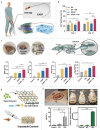
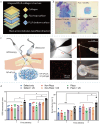

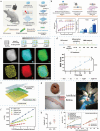
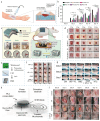

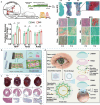

Similar articles
-
Property-tailoring chemical modifications of hyaluronic acid for regenerative medicine applications.Acta Biomater. 2025 Jul 1;201:75-100. doi: 10.1016/j.actbio.2025.06.014. Epub 2025 Jun 7. Acta Biomater. 2025. PMID: 40490241 Review.
-
Nature-Inspired Bioelectric Stimuli-Based Electroactive Polymeric Therapeutics Technology for Osteoarthritis Treatment─A Review.ACS Biomater Sci Eng. 2025 Jul 14;11(7):4002-4018. doi: 10.1021/acsbiomaterials.5c00480. Epub 2025 Jun 22. ACS Biomater Sci Eng. 2025. PMID: 40544500 Review.
-
Extracellular Vesicle-Integrated Biomaterials in Bone Tissue Engineering Applications: Current Progress and Future Perspectives.Int J Nanomedicine. 2025 Jun 17;20:7653-7683. doi: 10.2147/IJN.S522198. eCollection 2025. Int J Nanomedicine. 2025. PMID: 40546799 Free PMC article. Review.
-
Harnessing piezoelectric materials for tumor therapy: Current advances and outlook.Acta Biomater. 2025 Aug;202:66-84. doi: 10.1016/j.actbio.2025.06.058. Epub 2025 Jul 1. Acta Biomater. 2025. PMID: 40609606 Review.
-
Open Challenges and Opportunities in Piezoelectricity for Tissue Regeneration.Adv Sci (Weinh). 2025 Aug 18:e10349. doi: 10.1002/advs.202510349. Online ahead of print. Adv Sci (Weinh). 2025. PMID: 40823709 Review.
Cited by
-
Research trends of piezoelectric materials in neurodegenerative disease applications.Bioact Mater. 2025 Jun 13;52:366-392. doi: 10.1016/j.bioactmat.2025.06.022. eCollection 2025 Oct. Bioact Mater. 2025. PMID: 40585388 Free PMC article. Review.
-
Advances in applications of low-dimensional piezoelectric materials in musculoskeletal system.Mater Today Bio. 2025 Jul 7;33:102065. doi: 10.1016/j.mtbio.2025.102065. eCollection 2025 Aug. Mater Today Bio. 2025. PMID: 40688681 Free PMC article. Review.
References
-
- F. D. I. S. C. O. B. Edition , FDA approval of Ryoncil (remestemcel‐L‐rknd) for steroid‐refractory acute graft versus host disease in pediatric patients, https://www.fda.gov/drugs/resources‐information‐approved‐drugs/fda‐disco... (accessed: February 2025).
-
- E. M. Agency , Alofisel withdrawn from the EU market, https://www.ema.europa.eu/en/news/alofisel‐withdrawn‐eu‐market (accessed: February 2025).
-
- B. Carmen Pope , Ryoncil, https://www.drugs.com/ryoncil.html (accessed: February 2025).
-
- a) Mao Y. L., Wickström S. A., Nat. Rev. Mol. Cell Biol. 2024; - PubMed
- b) Maurer M., Lammerding J., Annu. Rev. Biomed. Eng. 2019, 21, 443; - PMC - PubMed
- c) Di X., Gao X., Peng L., Ai J., Jin X., Qi S., Li H., Wang K., Luo D., Signal. Transduct. Target Ther. 2023, 8, 282; - PMC - PubMed
- d) Du H., Bartleson J. M., Butenko S., Alonso V., Liu W. F., Winer D. A., Butte M. J., Nat. Rev. Immunol. 2023, 23, 174. - PMC - PubMed
Publication types
MeSH terms
Substances
Grants and funding
LinkOut - more resources
Full Text Sources

